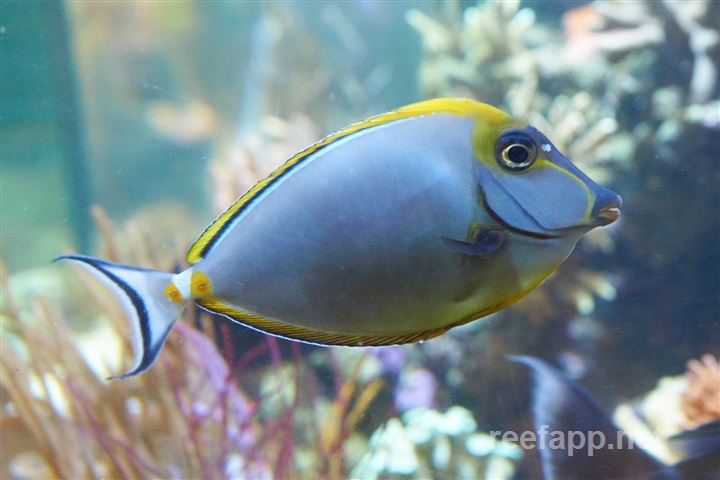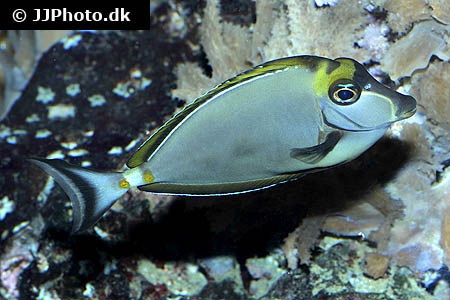Naso elegans




| Latin name | Naso elegans - (Rüppell, 1829) |
|---|---|
| Local name | Blonde Naso Tang |
| Family | Acanthuridae - Naso |
| Origin | East Indian Ocean, West Indian Ocean, The Red Sea, Indonesia |
| Max length | 45 cm (17.7") |
| Minimum volume |
900 l (237 gal) |
|---|---|
| Hardiness |
Delicate |
| Suitable for aquarium |
Suitable with care |
| Reef safe |
Always reef safe |
| Aggressiveness | Might be aggressive towards similar species |
| Recommended |
Macroalgea (Eg. seaweed / nori) Microalgea (Eg. spirulina) |
|---|---|
| Mostly |
Small crustaceans (Krill, mysis, artemia...) |
This species is known to jump out of open aquaria.
There are some experienced aquarists who have problems keeping this species alive, whilst some others are succesful and keep it for many years.
If one is one of the unlucky ones, it can happen that the fish suddenly die of unknown causes, after some time in captivity, even though it apparently looked healthy.
These fish should be kept in a well run aquarium where they can "graze" algae from rocks and stones.
If there are insufficient algae on the rocks, it is important to feed more frequently and supplement with algae rich food e.g. Spirulina.
This species revels in swimming and requires an aquarium with ample space.
This species requires places to hide, especially when newly introduced into the aquarium.
Even though these fish enjoy a diverse type of frozen foods, it is imperative that its primary food, is algae based, thus ensuring that the fish`s immune system remains healthy.
This can, for example, be plant based fish flakes, Nori seaweed or similar.
The colour of these fish becomes clearer when fully grown, and their tail becomes more lyre shaped over time.
To thrive, species in the Naso genus, normally demand large aquaria, both because of their size, but also to fulfil their need for swimming space.
Like other Surgeonfish, Naso, or Unicornfish, eats a great amount of algae, which should reflect in their food. They need more algae based food then other species of Surgeonfish, this one must be aware of so as not to create nutrition problems.
When newly introduced Naso can be in the aquarium without eating for some time, but they normally begin to eat within a week.
They are, on the whole a peaceful species in relation to other Surgeonfish.
It is important that one chooses a healthy individual at the petshop, i.o.w. a fish that is active, shows normal behaviour and does not look too thin. If it looks poorly one has a challenge on ones hand, especially when the fish takes its time to start eating.
Some sources report, that large Naso Surgeonfish can in some cases scratch acrylic and glass, since their scalpel grows larger then others of the species.
Surgeonfish (Acanthuridae) live primarily of different types of algae, making it a popular choice for coral aquariums, as they help to keep the aquarium algae free.
Most Surgeonfish have a scalpel by the caudal fin, used to defend themselves. It can cause some deep lacerations, so pay attention if the fish start to fight and when handling the fish.
When in the aquarium, they will spend most of their time swimming around and nibbling the algae from the stones. Surgeonfish will rarely irritate corals or invertebrates. Large Palettes/Blue tangs can be an exception.
The Surgeonfish are not typically aggressive towards other types of fish. If more Surgeonfish are added to the aquarium, they will establish a hierarchy. It is best to add the most aggressive species last and to ensure that there are sufficient hiding places, as they prefer to have their own individual sleeping area.
If multiple aggressive species are added to the same aquarium, one runs the risk of one of them dying due to stress. One must therefore be cautious about adding multiple Acanthurus species or Zebrasoma xanthurum into the same aquarium. A combination of the different genera will normally get along well, although the more aggressive species can still be challenging.
| Aquarium trade | No |
|---|---|
| Distribution | Indian Ocean: Red Sea south to Durban, South Africa and east through the islands of the western Indian Ocean to southwestern Indonesia, at least to Bali. Not reported from the Gulf of Oman, Persian Gulf, or India. Previously considered the Indian Ocean |
| English common names |
Smoothheaded unicornfish Indian orange-spine unicorn Elegant unicornfish Orangespine unicornfish |
| French common names |
Nasique à éperons oranges |
Mark Denaro. 2012. The Naso Tang - Tropical Fish Hobbyist - (English)
Bob Fenner. Unicorn Tangs, The Genus Naso, Family Acanthuridae - Wet Web Media - (English)
James W. Fatherree. 2009. Aquarium Fish: Surgeonfishes, A.K.A. the Tangs - Advanced Aquarist - (English)
Bob Fenner. Surgeons, Tangs and Doctorfishes, Family Acanthuridae - Wet Web Media - (English)
2013. Kirurgfisk - Saltvandswiki - (Danish)

